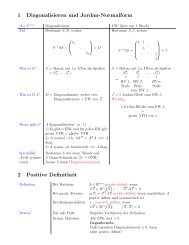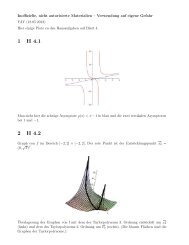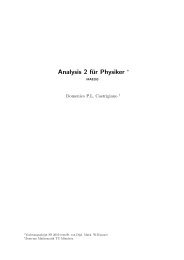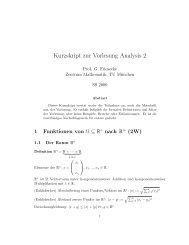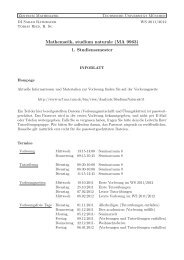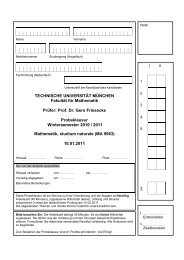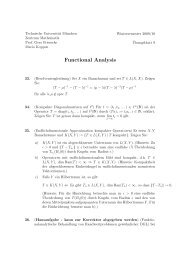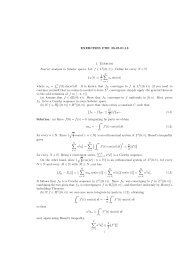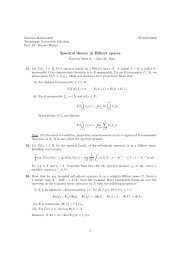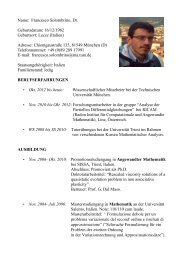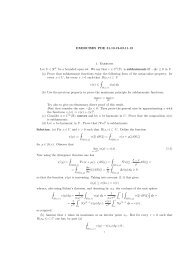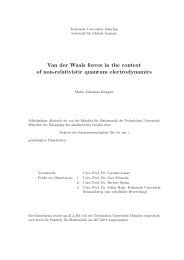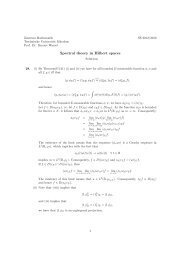Weak Convergence Methods for Nonlinear Partial Differential ...
Weak Convergence Methods for Nonlinear Partial Differential ...
Weak Convergence Methods for Nonlinear Partial Differential ...
Erfolgreiche ePaper selbst erstellen
Machen Sie aus Ihren PDF Publikationen ein blätterbares Flipbook mit unserer einzigartigen Google optimierten e-Paper Software.
Although this approach does not lead to a rigorous proof of u ε ⇀ u 0 , the<br />
solution of the equation above, this multi-scale analysis is an important first<br />
step: It provides us with an explicit <strong>for</strong>mula <strong>for</strong> the homogenized coefficients.<br />
Rigorous analysis:<br />
In the second part of the section we will give a rigorous convergence result.<br />
Suppose u ε is the (unique) weak solution of (3.13). We will now also distinguish<br />
more carefully between the operator L 1 and its <strong>for</strong>mal adjoint L ∗ 1 . (Of course,<br />
L 1 = L ∗ 1 if A is symmetric.) Define χ k = χ k (y), k = 1, . . .,n, to be a weak<br />
solution of the corrector problem<br />
n∑ (<br />
∂ yi aij (y)∂ yj χ k (y) ) =<br />
i,j=1<br />
n∑<br />
∂ yi a ik (y)<br />
i=1<br />
in Q<br />
subject to periodic boundary conditions. More precisely, χ k ∈ Hper 1 (Q) is such<br />
that<br />
∫ n∑<br />
∫ n∑<br />
a ij (y) ∂ yj χ k (y) ∂ yi ψ(y) dy = ∂ yi a ik (y) ψ(y) dy (3.24)<br />
Q i,j=1<br />
Q i=1<br />
<strong>for</strong> every ψ ∈ Hper(Q). 1 Here the Hilbert space Hper(Q) 1 of Q-periodic H 1 -functions<br />
consists of the restrictions to Q of Q-periodic functions belonging to Hloc 1 (Rn ).<br />
By Fredholm’s alternative, such functions χ k do exist. Also note that χ k is determined<br />
uniquely up to an additive constant. Define the homogenized coefficients<br />
by<br />
∫ n∑<br />
ā ij := a ik (y) (δ kj + ∂ yk χ j (y)) dy.<br />
Q<br />
k=1<br />
Theorem 3.13 u ε converges to u weakly in W 1,2<br />
0 (Ω), where u is the (unique)<br />
weak solution of<br />
−<br />
n∑<br />
∂ xj (ā ij ∂ xi u(x)) = f(x) in Ω, u = 0 on ∂Ω. (3.25)<br />
i,j=1<br />
Proof. As solutions to (3.13), the sequence (u ε ) is bounded in W 1,2<br />
0 (Ω). We may<br />
there<strong>for</strong>e extract a converging subsequence u ε ⇀ u in W 1,2<br />
0 (Ω). Since the weak<br />
solution of Equation (3.25) is unique, it suffices to show that u solves (3.25).<br />
For a further subsequence (not relabeled) we have<br />
n∑<br />
i=1<br />
( ·<br />
)<br />
a ij ∂ xi u ε ⇀ ξ j (3.26)<br />
ε<br />
78



